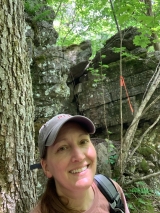Radford University
Karen Powers
Professor
Biology, Dept of
- Phone:
- (540) 831-6537
- Address:
-
Center for the Sciences 178
PO Box 6931 - Email:
- kpowers4@radford.edu


Courses Taught
- BIOL 103 - Environmental Biology
- BIOL 105 - Biology for the Health Sciences
- BIOL 160 - Freshman Biology Seminar
- BIOL 216 - General Zoology
- BIOL 232 - Organismal Biology
- BIOL 380 - Ornithology (coming soon!)
- BIOL 390 - Conservation Biology
- BIOL 460 - Senior Biology Seminar - Wildlife Management in Virginia
- BIOL 464 - Vertebrate Zoology
- BIOL 481 - Fire Ecology
- BIOL 481 - Research in Bird-Window Collisions
- BIOL 488/491/495 - Independent Research
About
My teaching interests focus on community ecology and wildlife management. I teach many of the -ology classes with focus on taxonomy, natural history, and use/development of our natural history collection. I also developed a course in Fire Ecology, which includes a prescribed burn of a restored native grassland at Radford University's Selu Conservancy.
I am the faculty advisor for the Radford University Student Chapter of The Wildlife Society (follow us on Facebook!) and for students with an interest in veterinary medicine. I also curate the natural history collection in the Biology Department.
My research interests are broad, encompassing many aspects of vertebrate ecology and habitat management. Recent projects and publications have focused on the effects of White-nose Syndrome on bat communities in the eastern United States and the status of Allegheny woodrats in Virginia. We have taken a turn to examining ectoparasites (bot flies and fleas) in woodrats in recent years. This summer work with bats and woodrats welcomes a small crew of 3-5, completing research across western Virginia.
On campus, we have been documenting bird-window collisions since 2018, and just published our 4th article with student authors. The bird-window collision research continues to welcome 8-10 students a semester, each student collaboratively collecting data and developing independent research questions based on our growing dataset.
Publications from 2019 to present are listed below, many with student co-authors (indicated by *).
- Thorne, E.D., K.E. Powers, R.J. Reynolds. M.E. Beckner*, K.A. Ellis*, and W.M. Ford. Accepted for publication. Comparison of survey methods to maximize detection of a declining rodent, the Allegheny woodrat (Neotoma magister), in Virginia. Journal of Fish and Wildlife Management.
- Lancaster, S.L.*, R.E.Salen*, E.H. Olsen-Hodges*, S.R. Simon*, and K.E. Powers. 2022. Techniques and trends in aging carcasses of bird-wind collisions in the New River Valley. Banisteria 56:18-24.
- Powers, K.E., D.M. Clore*, G.M. Davidson*, and R.C. Harris. 2022. A bird's-eye view: Novel use of drone images to quantify differences in altitudinal reflections in bird-window collision studies. American Midland Naturalist 187(1):51-61.
- Powers, K.E., R. Sheehy, M. Close, and B. Crawford*. 2022. Field note: Plestiodon fasciatus (Five-lined skink). Catesbeiana 42(1):33-34.
- Powers, K.E., L.A. Burroughs*, N.I. Harris III*, and R.C. Harris. 2021. Biases in bird-window collisions: A focus on scavengers and observer detection rates. Southeastern Naturalist 20(2):293-307.
- Powers, K.E., T.H.D. Marshall*, L.M. Van Meter*, R.R. Sheehy, and S. Garvin. 2020. Parasite loads and aging techniques assess the condition of a bobcat (Lynx rufus) kitten in Virginia. Banisteria 54:N14-N22.
- Powers, K.E., M.T. Mengak, R.R. Sheehy, W.M. Ford, and R.J. Reynolds. 2020. Bot fly parasitism of Allegheny woodrats (Neotoma magister) in Virginia. American Midland Naturalist 184: 62-72.
- Powers, K.E., J.E. Raymond, K.L. Titus*, H.N. Custer*, S. Brandes*, and J.S. Lucas. 2020. Assessment of small Indian mongoose diet on St. John, USVI, using stable isotope analyses. Caribbean Naturalist 73:1-14.
- Powers, K.E., M.S. Dimas*, A.I. Leon*, and L.M. Vanmeter*. 2020. Observed predation of Neotoma magister (Allegheny woodrat) by Strix varia (barred owl) in Virginia. Northeastern Naturalist 27(1):N1-N5.
- Allen, E.T.*, K.E. Powers, C.J. Small, and T.F. Wielboldt. 2020. County additions to the Virginia flora vouchered at the Radford University Herbarium. Castanea 85(1):14-22
- Powers, K.E., L.A. Burroughs*, B.M. Mullen*, H.C. Reed*, and Z.Q. Krajcirovic*. 2019. Investigating campus features that influence bird-window collisions at Radford University, Virginia. Banisteria 53:11-21.
- Paniagua-Ugarte, C.Y.*, K.E. Powers, and R.R. Sheehy. 2019. Using DNA barcoding to identify carcasses from bird-window collisions at Radford University. Banisteria 53:22-26.
- Muthersbaugh, M., A. Silvis, K.E. Powers, W.M. Ford. 2019. Activity patterns of cave-dwelling bat species during pre-hibernation swarming and post-hibernation emergence in the central Appalachians. Diversity 11:159.
- Muthersbaugh, M., W.M. Ford, K.E. Powers, and A. Silvis. 2019. Activity patterns in regional and long-distance migrant bat species during the fall and spring along ridgelines in the central Appalachians. Journal of Fish and Wildlife Management 10(1):180-195.
- Austin, L., A. Silvis, W.M. Ford, and K.E. Powers. 2019. Effects of historic wildfire and prescribed fire on site occupancy of bats in Shenandoah National Park, Virginia, USA. Journal of Forestry Research. DOI 10.1007/s11676-019-00923-y
Students interested in independent research (BIOL 488/491) or internship (BIOL 495) credits throughout the year (including summer months) are welcome to contact me to participate in on-going projects. **Special consideration will be given to those active in the Radford University Student Chapter of The Wildlife Society.
Inquiries from regional researchers interested in developing field projects with vertebrate communities also are encouraged.